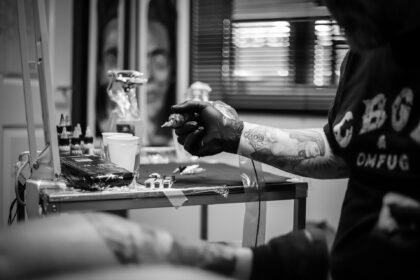Tattoos are a form of permanent self-expression, but over time, they can change in appearance. One common concern among tattoo enthusiasts is, “Why do tattoos turn green?” This change happens primarily in older tattoos, especially those that use black ink. Understanding why this happens and how to prevent it can help you maintain your tattoo’s vibrancy for years. The answer lies in a combination of ink composition and how tattoos interact with your skin over time.
What Causes Tattoos to Turn Green?
The change in color that causes black tattoos to turn green happens due to the pigments used in the ink. Black ink is often a blend of various pigments, including blue and green. Over time, as the black pigments fade, the remaining green tattoo pigments become more prominent.
Several factors contribute to this transformation, including prolonged UV exposure, natural skin aging, and the quality of ink used. Poor-quality ink may break down faster, leading to color changes sooner than expected. The ink’s reaction with your body’s immune system also plays a role in how quickly a tattoo fades.
You can read more about Mastering Ink Mixology: A Tattoo Artist’s Guide to Custom Colors.
Why Does Only Black Ink Turn Green?
Many wonder why black ink is particularly prone to turning green while other colors don’t undergo the same transformation. The answer lies in the pigments. Black tattoo ink often contains a mix of blue and green hues. As the tattoo ages and the darker pigments break down, the green pigment remains visible. This is why you often see older black tattoos turning green but not red or yellow tattoos, which are made of different pigment blends.
Modern Tattoo Inks: Will They Still Turn Green?
With advancements in modern tattoo ink, there is hope that newer tattoos will not experience the same greenish tint as older ones. Tattoo ink has evolved, and today’s formulations are designed to be more resistant to fading. However, since tattoos take years to show their age, it’s still too early to say for sure if modern inks are immune to this problem. Despite the improvements, regular care and protection from sunlight are still crucial in maintaining the color of a tattoo long-term.
How to Prevent Tattoos from Turning Green
You can prevent your tattoo from turning green by taking some proactive steps. First, choose a reputable artist who uses high-quality tattoo ink that is designed to last. Always ask about the types of pigments used and how they age over time.
Aftercare is another essential factor in preventing fading. Apply sunscreen to your tattoo whenever it’s exposed to sunlight, as UV rays speed up the fading process. Moisturizing the tattoo regularly also keeps your skin healthy and reduces color degradation. If you want your tattoo to stay vibrant, consider touch-ups every few years to refresh the colors.
What to Do if Your Tattoo Turns Green
If you notice your tattoo starting to turn green, don’t worry. You have several options to restore its original color. One solution is to get a tattoo touch-up, where a tattoo artist re-applies ink to the faded areas. Another option is a tattoo cover-up, which involves adding new design elements or colors to refresh the look.
For those who want to remove the green entirely, laser tattoo removal is a viable option. Lasers break down the pigments, allowing your body to absorb and eliminate them. However, this process requires multiple sessions and can be costly.
Final Words
Tattoos are bound to age over time, and in many cases, black tattoos turning green is part of that process. However, by choosing quality ink, practicing good aftercare, and staying vigilant with touch-ups, you can keep your tattoo looking fresh for years. Understanding the reasons behind tattoo color changes allows you to take the necessary steps to prevent fading and maintain the vibrant appearance of your ink.





